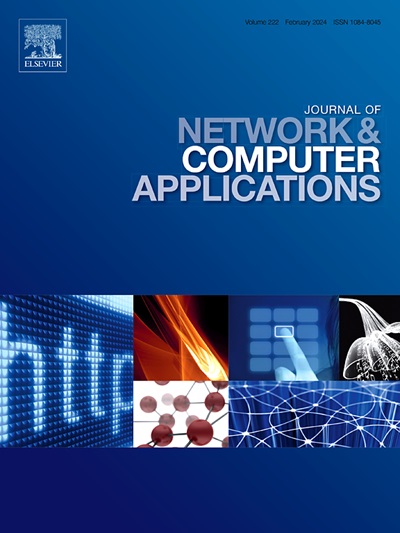PRAETOR:Packet flow graph and dynamic spatio-temporal graph neural network-based flow table overflow attack detection method
IF 8
2区 计算机科学
Q1 COMPUTER SCIENCE, HARDWARE & ARCHITECTURE
引用次数: 0
Abstract
The flow table overflow attack on SDN switches is considered to be a destructive attack in SDN. By exhausting the computing and storage resources of SDN switches, this attack severely disrupts the normal communication functions of SDN networks. Graph neural networks are now being employed to detect flow table overflow attacks in SDN. When a flow graph is constructed, flow features are commonly utilized as nodes to represent the characteristics of flow table overflow attacks. However, a graph solely relying on these nodes and attributes may not fully encompass all the nuances of the flow table overflow attack. Additionally, GNN model may be difficult in capturing the graph information between different flow graphs over time, thus decreasing the detection accuracy of packet flow graph. To address these issues, we introduce PRAETOR, a detection method for flow table overflow attacks that leverages a packet flow graph and a dynamic spatio-temporal graph neural network. More particularly, The PaFlo-Graph algorithm and the EGST model are introduced by PRAETOR. The PaFlo-Graph algorithm generates a packet flow graph for each flow. It utilizes packet information to construct the graph with more detail, thereby better reflecting the characteristics of flow table overflow attacks. The EGST model is a dynamic spatio-temporal graph convolutional network designed to detect flow table overflow attacks by analyzing packet flow graphs. Experiments were conducted under two network topologies, where we used tcpreplay to replay packets from the bigFlow dataset to simulate SDN network flow. We also employed sFlow to sample packet features. Based on the sampled data, two datasets were constructed, each containing 1,760 network flows. For each packet, eight key features were extracted to represent its characteristics. The evaluation metrics include TPR, TNR, accuracy, precision, recall, F1-score, confusion matrix, ROC curves, and PR curves. Experimental results show that the proposed PaFlo-Graph algorithm generates more detailed flow graphs compared to KNN and CRAM, resulting in an average improvement of 6.49% in accuracy and 8.7% in precision. Furthermore, the overall detection framework, PRAETOR, achieves detection accuracies of 99.66% and 99.44% on Topo1 and Topo2, respectively. The precision scores reach 99.32% and 99.72%, and the F1-scores are 99.57% and 100%, respectively, indicating superior detection performance compared to other methods.
PRAETOR:基于数据包流图和动态时空图神经网络的流表溢出攻击检测方法
针对SDN交换机的流表溢出攻击被认为是SDN网络中的一种破坏性攻击。该攻击通过耗尽SDN交换机的计算和存储资源,严重破坏SDN网络的正常通信功能。图神经网络目前被用于检测SDN中的流表溢出攻击。在构建流图时,通常使用流特征作为节点来表示流表溢出攻击的特征。然而,仅仅依赖于这些节点和属性的图可能无法完全包含流表溢出攻击的所有细微差别。此外,随着时间的推移,GNN模型可能难以捕获不同流图之间的图形信息,从而降低了包流图的检测精度。为了解决这些问题,我们引入了PRAETOR,这是一种利用数据包流图和动态时空图神经网络的流表溢出攻击检测方法。具体地说,PRAETOR介绍了PaFlo-Graph算法和EGST模型。PaFlo-Graph算法为每个流生成数据包流图。它利用报文信息构造更详细的图,从而更好地反映了流表溢出攻击的特点。EGST模型是一个动态的时空图卷积网络,旨在通过分析数据包流图来检测流表溢出攻击。实验在两种网络拓扑下进行,其中我们使用tcpreplay来重播来自bigFlow数据集的数据包来模拟SDN网络流。我们还使用sFlow对数据包特征进行采样。基于采样数据,构建了两个数据集,每个数据集包含1760个网络流。对于每个数据包,提取8个关键特征来表示其特征。评价指标包括TPR、TNR、正确率、精密度、召回率、f1评分、混淆矩阵、ROC曲线、PR曲线。实验结果表明,与KNN和CRAM算法相比,本文提出的PaFlo-Graph算法生成的流图更加详细,准确率平均提高6.49%,精度平均提高8.7%。此外,整体检测框架PRAETOR在Topo1和Topo2上的检测准确率分别达到99.66%和99.44%。精密度得分达到99.32%、99.72%,f1得分分别达到99.57%、100%,检测性能优于其他方法。
本文章由计算机程序翻译,如有差异,请以英文原文为准。
求助全文
约1分钟内获得全文
求助全文
来源期刊

Journal of Network and Computer Applications
工程技术-计算机:跨学科应用
CiteScore
21.50
自引率
3.40%
发文量
142
审稿时长
37 days
期刊介绍:
The Journal of Network and Computer Applications welcomes research contributions, surveys, and notes in all areas relating to computer networks and applications thereof. Sample topics include new design techniques, interesting or novel applications, components or standards; computer networks with tools such as WWW; emerging standards for internet protocols; Wireless networks; Mobile Computing; emerging computing models such as cloud computing, grid computing; applications of networked systems for remote collaboration and telemedicine, etc. The journal is abstracted and indexed in Scopus, Engineering Index, Web of Science, Science Citation Index Expanded and INSPEC.
 求助内容:
求助内容: 应助结果提醒方式:
应助结果提醒方式:


